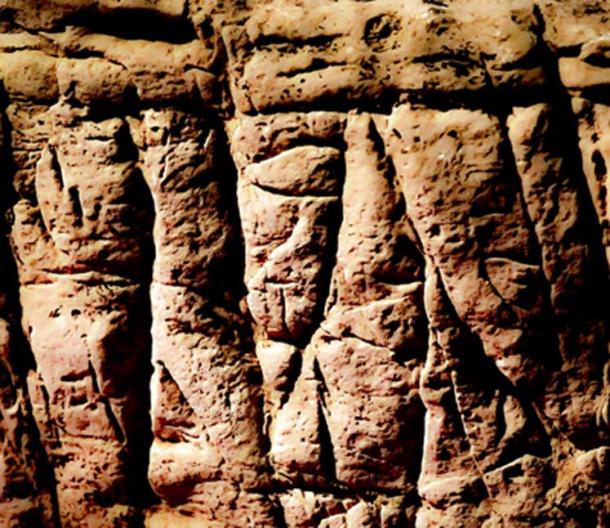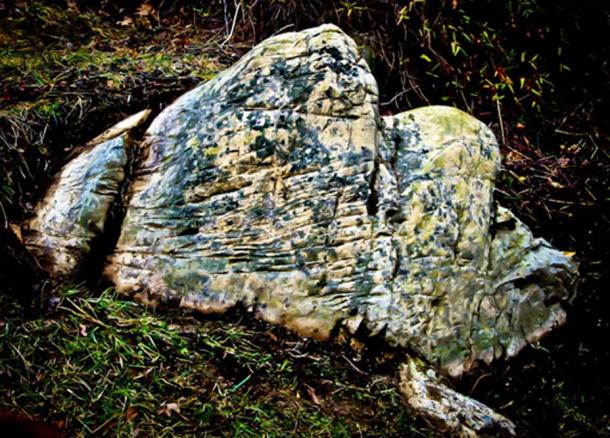The Lost Tribe of Clover Hollow – Oldest Civilization in the World Found in Appalachian Mountains?
The Appalachian Orogeny is one of the geological mountain building events that created the Appalachian Mountains. This orogeny occurred about 325 million years ago and was caused by Africa colliding with North America at a time when these continents did not exist in their current forms. It applied massive stress on what is today the Eastern Seaboard of North America, forming a wide and high mountain chain. The Appalachians likely once reached elevations similar to those of the Alps, Andes, and the Rocky Mountains before they were eroded down to what they are today. The Appalachian Mountains are some of the oldest mountains in the world.
Age of the Mammals
About sixty-six million years ago, the Appalachian Mountains had been eroded to an almost flat plain. It was not until the region was uplifted during the Cenozoic Era (sixty-five million years ago to the present) that the distinctive topography of the Appalachian Mountains formed. Running across and through the ridge and valley region of the Appalachians is the New River which is believed to have existed before this second mountain building process began. This era is known as the ‘Age of the Mammals.’ This uplifting rejuvenated the streams, which rapidly responded by cutting downward into the ancient bedrock. Some streams flowed along weak layers that define the folds and faults created many millions of years earlier. Sinking Creek, a side stream of the New River, is an example of this process.
This part of the Appalachians is strung with gaps, which are small passes in the mountain front. Those with streams flowing through them are called water gaps. Sinking Creek is a prehistoric tributary running west into one of the oldest river systems in the world ironically called the ‘New’. The New River is the oldest river on the North American continent and second only to the Nile in Africa. It may have been on its present course for at least sixty-five million years and flows directly across the Appalachian Plateau, not around or from it, as most other streams of this region do. This river had to exist before the mountains formed as it has carved through more than ten-thousand feet (about two miles, 3.2 km) of their strata.

Sinking Creek, Virginia
The Appalachian Mountains created a formidable barrier for east-west travel. One way past this barrier was the New River Valley, a great example of a mountain pass. A mountain pass is a route through a mountain range or over a ridge. Mountain passes make use of a gap, saddle, notch, or the low point in a ridge. Passes have been important since before recorded history and have played a key role in trade, war, and migration. The New River Valley was an ancient passageway and migration route to or from the Ohio River Valley. It has been shown all over the world, these early river valleys and passes are where most ancient civilizations chose to settle and prosper, whether it was for food, shelter, or for Earth’s hidden energy waiting to be harvested.
Early Pioneers
One such water gap in the Appalachian Mountains of Virginia shows the early remnants of an American colony and their quest for finding rich fertile land to farm, and fast water to run their mills to produce the energy they needed to survive. It is located at the base of Clover Hollow Mountain and adjacent to Sinking Creek, an extremely ancient branch of the New. It is no wonder early pioneers chose this particular spot to build their colony. Clover Hollow was a very strategic location that offered them protection from the elements as well as offering safety and security from the unknown wilderness that surrounded them. As far as they knew, they were the first humans ever to settle on this land. What you do not see on the surface is the inadvertent iconoclastic behavior perpetrated by the New River German Settlement.
What is meant by inadvertent iconoclastic behavior is the accidental destruction and construction of one civilization on top of a more ancient civilization. This phenomena is well documented all over the world including in Egypt and Peru. Now, an accident of history has been exposed on a Virginia Appalachian mountainside. Scattered across Clover Hollow Mountain is a whole complex of petroglyphs of unknown origin intimating important cultural and strategic stone alignments. For this discussion we can call it the ‘Lost Tribe of Clover Hollow.’
Lost Tribe of Clover Hollow
Before european pioneers colonized the western frontier of Virginia, Clover Hollow Mountain lay within the sacred hunting grounds of the Cherokee. Imagining this area before the old mill and dam existed would reveal a V shaped passageway, or water gap, heading northwest through the Appalachian Mountains. Sinking Creek would have been rushing rapids falling ten or fifteen feet (4.5 meters) in elevation as it flowed past this spot, very much like it still is today at the bottom of the dam. Sinking Creek gets it’s rich olive color from the abundant iron deposits that have become one with the creek. Perhaps there was once a stunning waterfall crashing on the rocks below with surrounding forests teeming with wildlife.

Layout of the petroglyphs at Gateposts, and an ancient trail along Sinking Creek.
Both the south and north sides of Sinking Creek would have risen steeply with rock formations covering both sides. A narrow ancient Native American trail would have wound itself along the south side of Sinking Creek alongside the steep cliff, and the north side would rise steeply toward the sky, unchanged from what it is today. The creation of the dam and millpond in the early 1800’s effectively cut off the north side of Sinking Creek from any human contact since. The only thing that has changed on the north side of the creek since the millpond was created is the water level. You can still imagine the steep slope of the creek side continuing further down under the water of the millpond.
Petroglyphs and Stone Alignments
Ancient cultural influences detected at Clover Hollow include strange and mystical stone alignments. Facing each other across Sinking Creek are two rock outcroppings that stand there like the piers of a gate. The carvings on these ‘gateposts’ are the same abstract facial features and artistic self expression as found on all the rock formations at the site—very anthropomorphic in style and design. They look as though they could be straight out of an Indiana Jones movie. All of the ancient rock carvings at this site are 3D in nature and could be described as ‘petroglyphs of the broad type’ as one archaeologist has suggested.

Stones at the Gatepost locations

Rock cuts, or possible petroglyphs

Rock cuts, or possible petroglyphs

Rock cuts, or possible petroglyphs
There are other peculiar stone alignments indicating cultural influences that apply to all the rock formations. Only by studying photographs of the rock outcroppings taken during the winter months when all the leaves were gone, was it determined that particular curious alignments were shared by all the stone structures. The rock formations on the south side of Sinking Creek appear to be all facing a northerly direction toward one particular circular rock configuration on the north side of the creek. In addition, all the petroglyphs on the north side of Sinking Creek appear to be aligned facing right, in the direction of the same circular stone formation the petroglyphs on the south side are facing.

Stones at Gateposts along the North and South banks of the Sinking Creek.
Unknown Origins
It shouldn’t be surprising an ancient civilization of unknown origin has been found in the Appalachian Mountains. These mountains are ten times older than for example the Andes, where numerous ancient cultures like Ollantaytambo, Saksayhuaman, and Machu Picchu, overlook a much newer Urubamba River Valley. It may be true however, that the oldest civilizations on Earth once thrived in the Appalachian region of North America only to have been ravaged by time and is now eroding, and crumbling into dust and eternity. Luckily the ‘Lost Tribe of Clover Hollow’ has been found and should encourage another look into the ancient origins of the Appalachian Mountains.
Dave Miller is author of the book The Sibold Effect: Beyond Science, History, Ghosts, and the Appalachian Supernatural . Find out more at his website TheSiboldEffect.com
MORE
Stone Panels of Clover Hollow --Wondrous Freaks of Nature or Cryptic Messages from the Ancient Past?
The Mysterious Lost Colony of Roanoke Island Vanished, Leaving Behind a Strange Message
Archaeologists Uncover Tantalizing Evidence of the Lost Colony of Roanoke
Will the Secrets Behind the 5000-year-old Cochno Stone Finally Be Solved?
--
Top Image: Enigmatic stone markings on the banks of Sinking Creek, in the Appalachian Mountains. © Dave Miller
All Images courtesy © Dave Miller
By Dave Miller


















Comments
Here in the Midwest, remnants of the Hopewell (and other) cultures, muted though they are, provide valuable and important clues to the ancient peoples of this continent. I myself have investigated some very curious rock formations in Upper Michigan; I still cannot determine (and I am a strict amateur) if these are, in fact, artificially-created objects or merely a bizarre combination of natural forces.
This being said, it would be helpful if some type of historical evidence had been provided, to assist in the author's claims of the lost tribe, whether it be Hopewell, Early Woodland, Adena, et al. Also (speaking as an architect) a ground plan or partial aerial survey would provide important information, as well.
Sanjay R Singhal, RA
Sanjay R Singhal, RA
I grew up in the Western Pennsylvania area and spent many days as a child, and a young adult fossil hunting in both Pennsylvania and West Virginia. During that time I became more than a little familiar with the terrain and it’s rock formations in those areas, and I believe that what we are seeing in these photos is nothing more than erosion.
Beautiful formations yes, but man made? I see no evidence that these are anything more than the result of natural erosion. Be it hydrological or glacial erosion, they are still a natural phenomena and in no way a product of homo sapiens.
R. Lee Bowers
“The oldest civilization on earth”? First off, John Cargill is probably right, the rock markings look more like glacial marks and ordinary fracture lines than any petroglyphs I have seen. Having studied both anthropology and geology in BC I’ve seen a fair amount of both. This sound far more like wishful thinking or an anywhere but Africa theory.
HMF
Good post. I am looking into these issues on my blog….
I've lived here pretty much my entire life. My ancestors were among the first pioneers to settle here and never heard anyone outside Mr. Miller speak of anything like this. Giles county is just one big limestone rock quarry and every holler has its own incrediable looking rock formations that with a good imagination could easily fit the narrative if not more so. There's no doubt this area has a mystical ancient feel to it but it's also a geological anomaly and nothing more. When you walk in the woods in this area there's no doubt you get a feeling of sorts but this is kind of a leap. VIrginia Tech is only 27 miles away with a outstanding anthropology and geology departments that are constantly poking around in the country side and have never broached such a theory
Pages